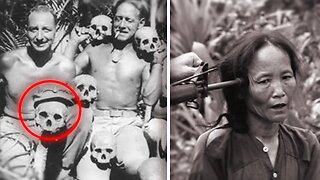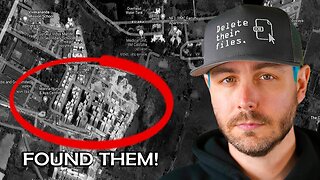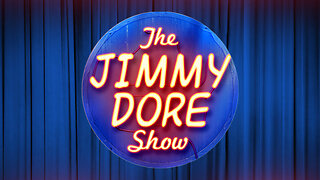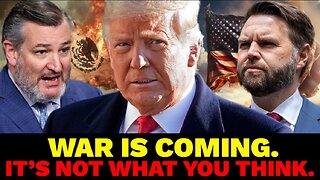Premium Only Content

This Sinister Air Bombing Annihilated 100,000 Civilians
By early 1945, the outcome of the Second World War was obvious to anyone. Italy had been knocked out, Germany was retreating on all fronts, and the Americans were within striking distance of the Japanese mainland.
The question the Allies faced was how to end the war as quickly, and with as few casualties, as possible. This thinking would lead to one of the most controversial Allied actions of the war: the fire-bombing of Tokyo, codenamed Operation Meetinghouse.
In this video, we’ll explore what Operation Meetinghouse was and ask whether it was the right call. If you enjoy this video, don’t forget to like and subscribe for more videos like this one.
Lead-Up
With the conquest of Guam and the Marianas in early 1945, American bombers could now reliably strike Japan itself. Allied leadership began to consider how they might undertake an invasion of Japan once Germany had been defeated in Europe. Certainly, Japan would have to be weakened first. Its industrial capacity had to be crippled and its population demoralized to pave the way for a full-scale invasion.
This was the issue faced by Major General Curtis LeMay, Commander of the 21st Bomber Command in the Pacific. LeMay addressed this problem the same way the Allies had solved the issue in Europe, with the most American solution of all: bombs.
LeMay and the US military leadership knew that a strategic bombing campaign on Japanese cities would cripple their industry and demoralize the population, much as it had done in Germany. These bombing campaigns would inevitably target civilians, but this didn’t phase LeMay or any of the US leadership. After all, the entire conflict had seen atrocity upon atrocity inflicted on non-combatants, and, ultimately, the US believed that the civilian costs were worth the potential saving of military lives.
#history #operationmeetinghouse #bombingoftokyo #ww2
Scriptwriter: Nathan Hewitt
Video Editor & Motion Graphics: LC
Voice-over Artist: Lain Heringman
Music: Epidemic Music
Sources
Curits LeMay and MacKinlay Kantor, Mission with LeMay: My Story, (1965)
Edwin Hoyt, Inferno: The Firebombing of Japan, March-August 15, 1945, (2000)
Marc Selden, ‘A Forgotten Holocaust: US Bombing Strategy, the Destruction of Japanese Cities & the American Way of War from World War II to Iraq’, in Yuki Tanaka and Marilyn B. Young (eds.), Bombing Civilians: A Twentieth-Century History, (2009), pp77-96
United States Strategic Bombing Survey Summary Report (Pacific War), 1st July 1946, https://www.anesi.com/ussbs01.htm
Copyright © 2021 A Day In History. All rights reserved.
DISCLAIMER: All materials in these videos are used for entertainment purposes and fall within the guidelines of fair use. No copyright infringement intended. If you are, or represent, the copyright owner of materials used in this video, and have an issue with the use of said material, please send an email to adayinhistory2021@gmail.com
-
 19:31
19:31
A Day In History
1 year ago $0.15 earnedBIGGEST American War Crime Cover-Up Of The Vietnam War (Warning* Mature Audiences Only)
6011 -
 LIVE
LIVE
SNEAKO
5 hours agoCheesur edate, Jake Shields on election
4,749 watching -
 39:34
39:34
Nerdrotic
7 hours ago $17.64 earnedAirbursts with Dr Malcolm LeCompte & Giants and Ancient Civilizations with Hugh Newman
77.1K5 -
 1:03:38
1:03:38
vivafrei
14 hours agoElection RECAP! Long-Count Chicanery! FULL Jan. 6 Pardons! Let's Mock Lichtman & MORE! Viva Frei
138K151 -
 LIVE
LIVE
Vigilant News Network
8 hours agoDoctors Drop Post-Election COVID Bombshell | Media Blackout
4,966 watching -
 14:13
14:13
Scammer Payback
12 days agoTelling Scammers Their Address
147K85 -
 5:43:21
5:43:21
Barstool Gambling
12 hours agoBig Cat and Co Sweat Out the Week 10 Sunday Slate | Barstool Gambling Cave
107K3 -
 2:49:36
2:49:36
The Jimmy Dore Show
2 days agoRumble Time Live w/ Jimmy Dore & Special Guests Roseanne Barr, Dr. Drew, Drea de Matteo & More!
572K664 -
 17:17
17:17
DeVory Darkins
1 day agoKamala Post-Election BOMBSHELL Exposes $1 BILLION Campaign DISASTER
98.8K179 -
 19:52
19:52
Stephen Gardner
1 day ago🔥HOLY CRAP! Trump just did the UNTHINKABLE!!
100K586